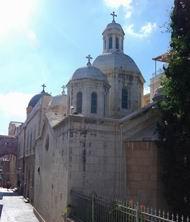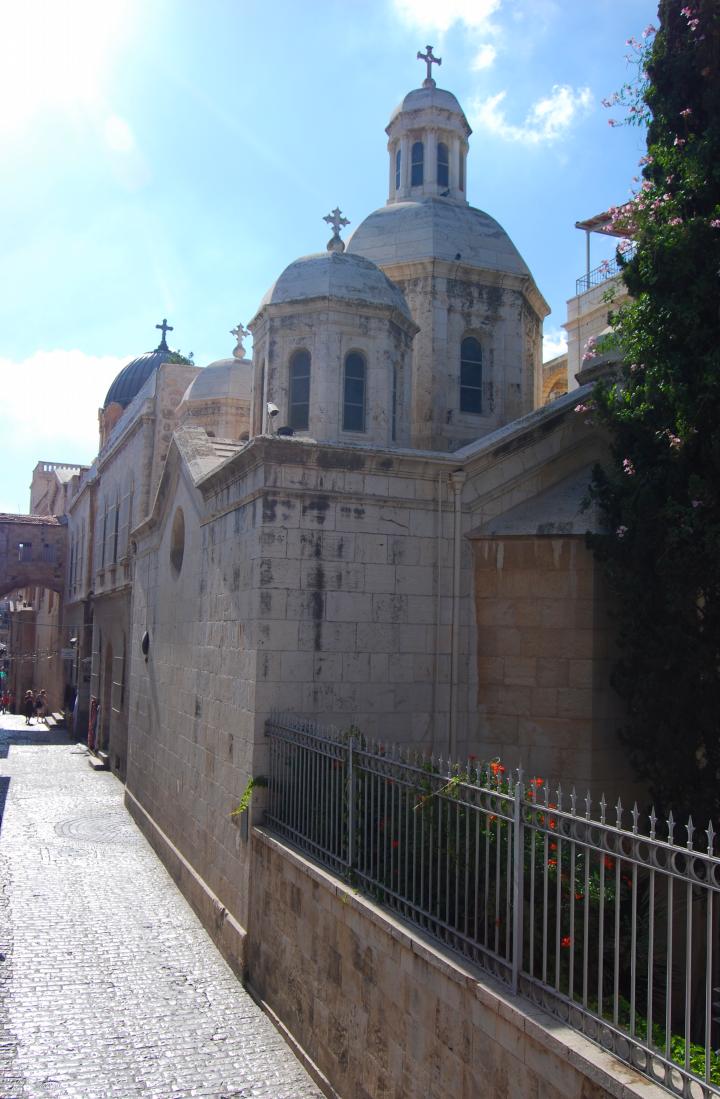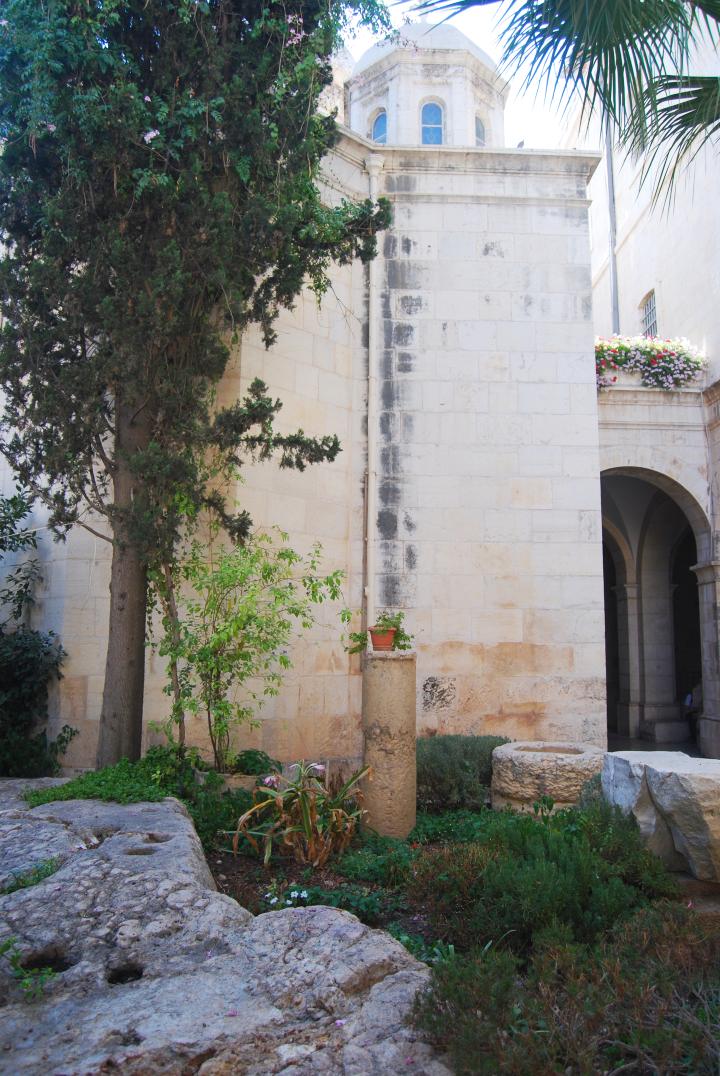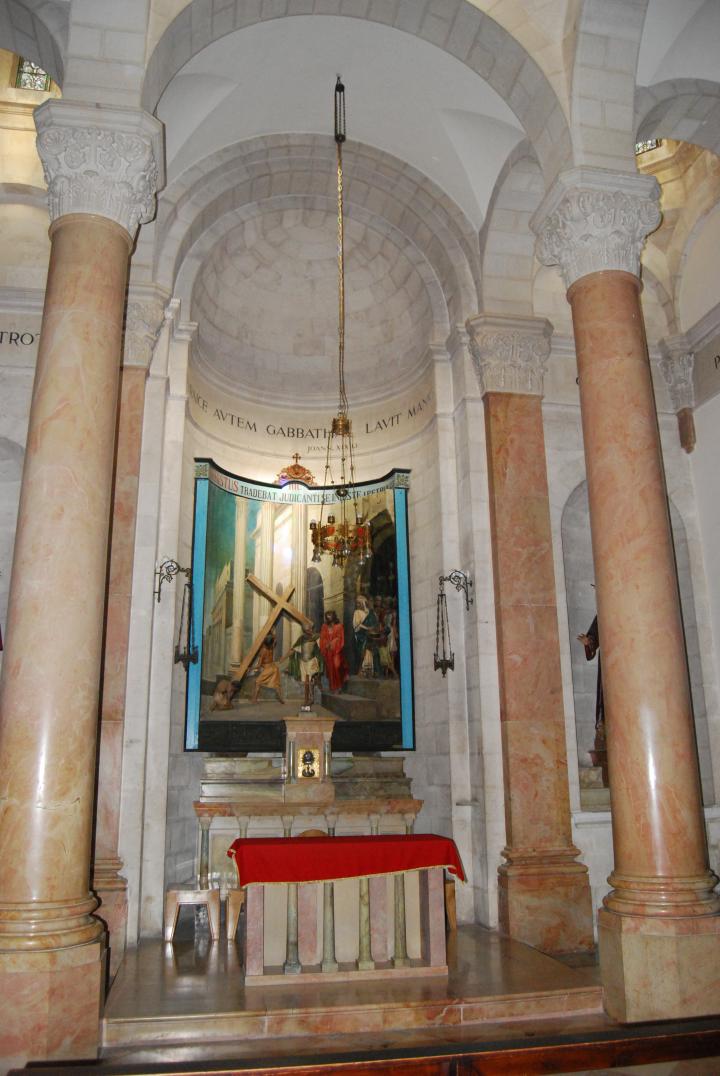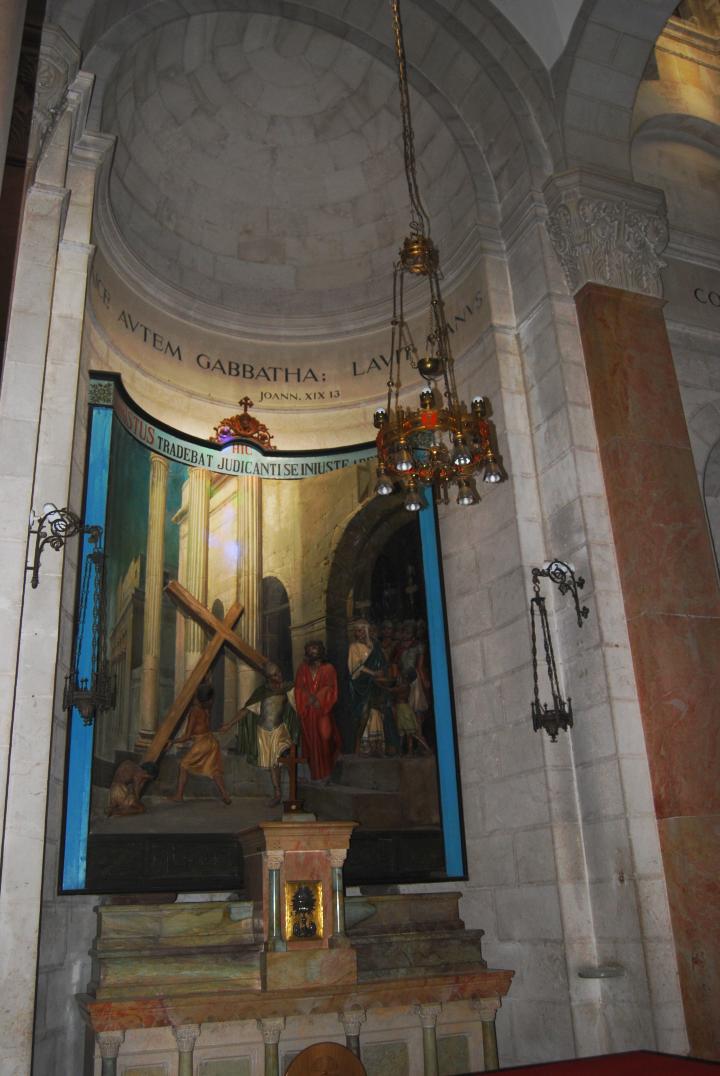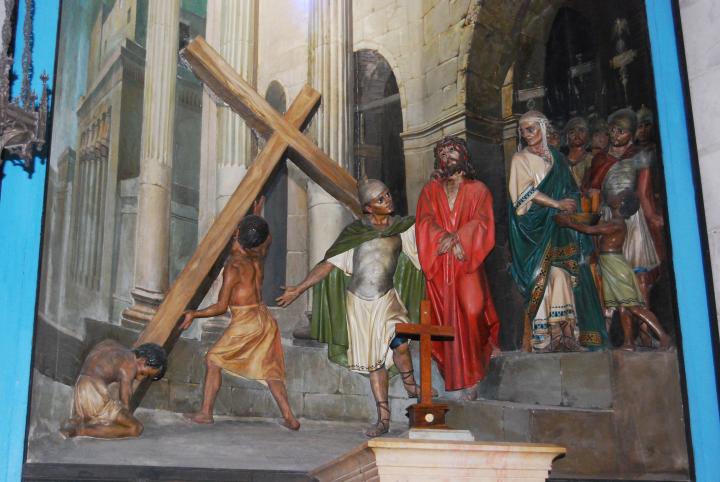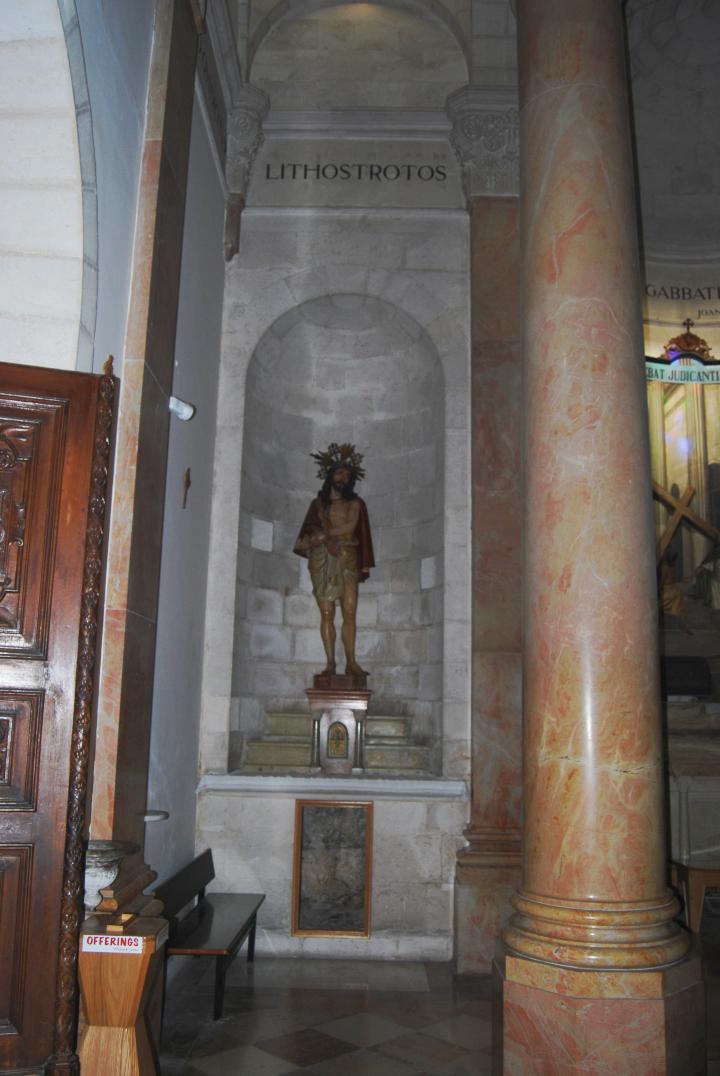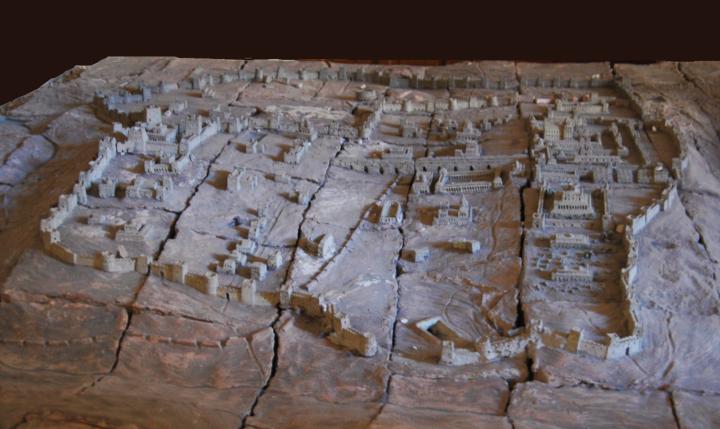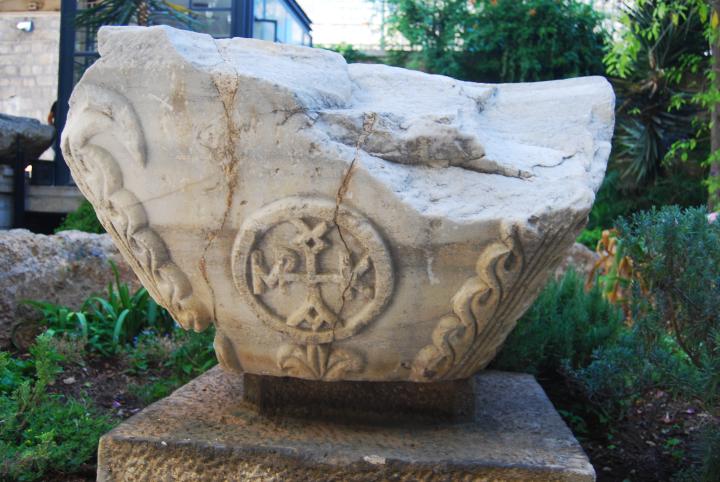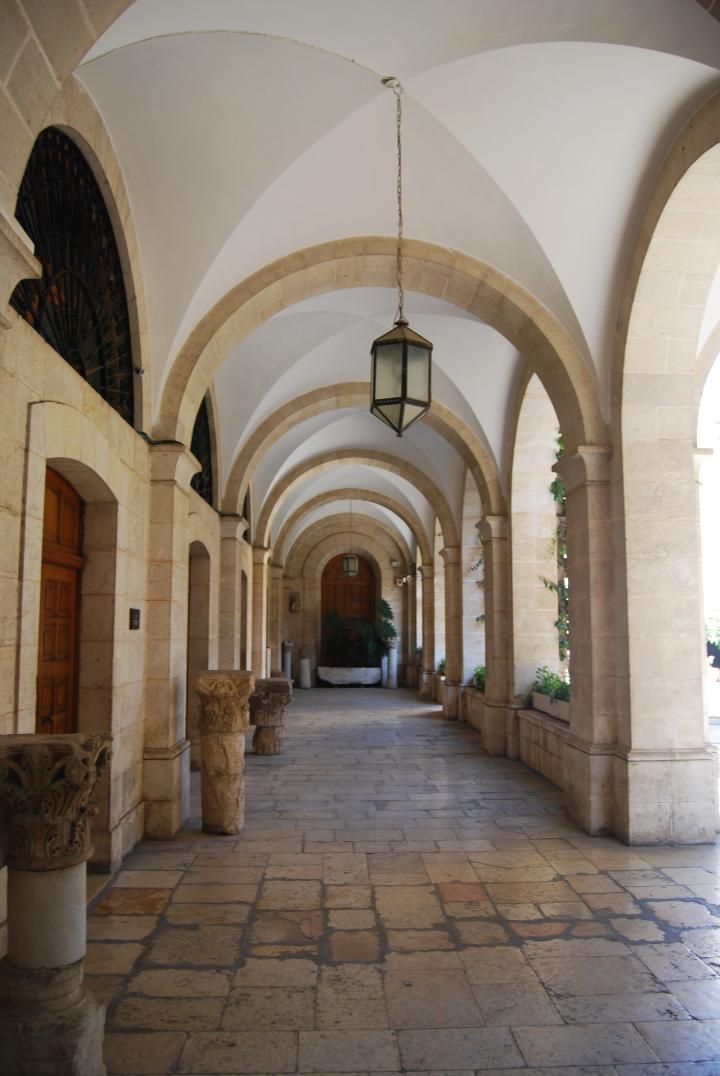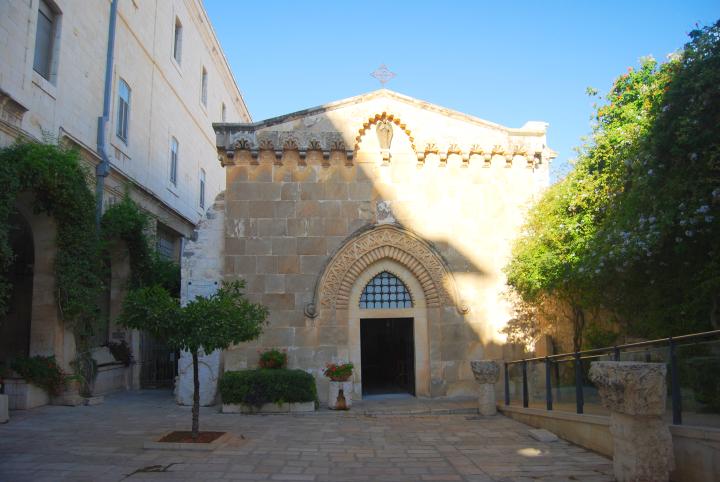A Roman Catholic Church on Via Dolorosa (station II). According to tradition, this was the site where Jesus took up his cross after being sentenced.
Home > Sites > Jerusalem > Church of the Condemnation and Imposition of the Cross
Contents:
Overview
Location
History
Photos
Etymology
Links
Overview:
The Catholic Franciscan chapel of the “Condemnation and Imposition of the Cross” is located in their complex at station #2 of Via Dolorosa. According to tradition, this was the site where Jesus took up his cross after being sentenced. It is based on the finding of large Roman pavement stones that may have been part of Pilate’s judgment seat for the condemnation of Jesus, and the place where Jesus took up his cross after being sentenced.
John 19:13: “When Pilate therefore heard that saying, he brought Jesus forth, and sat down in the judgment seat in a place that is called the Pavement, but in the Hebrew, Gabbatha”.
Location and Aerial map:
The church is located on the eastern side of Via Dolorosa inside the Franciscan complex, adjacent to the Flagellation church.
In the Aerial map below (with a view from the north) the churches of Condemnation and Flagellation are located in the center, along Via Dolorosa street.
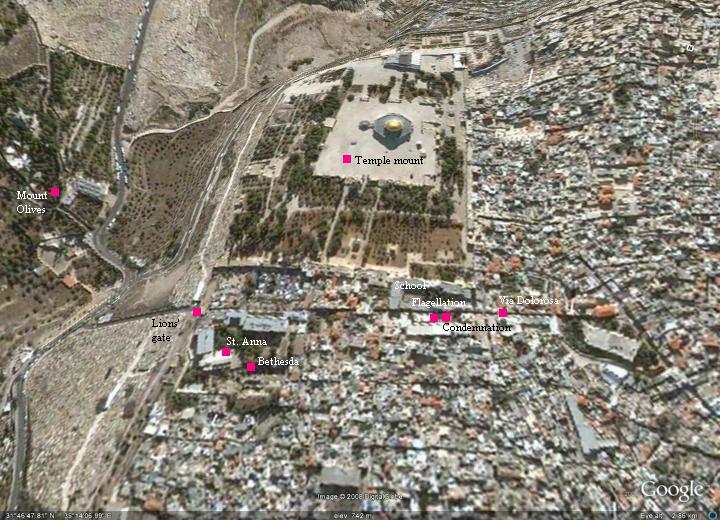
History:
- Roman Period
The site in the vicinity of the church of Condemnation was in the Roman times the place of the seat of Pontius Pilate, located in the Antonia fortress, and the place of the hall of judgment. John 18:28: “Then led they Jesus from Caiaphas unto the hall of judgment”. Jesus is condemned to death by Pontius Pilate, as per John 19:16: “Then delivered he him therefore unto them to be crucified”.
Inside the church (on its western floor), and outside the chapel, are huge stones which were part of the Roman pavement dated to the 2nd century.
- Crusaders period
An earlier chapel was located at the site of the Condemnation chapel. Its construction is dated to the years 1229-1244. It was ruined in the 13th century.
The Franciscan order was established by Saint Francis, an Italian who lived in the late 12th century. The Franciscans presence in the Holy Land started in the early 13th century, when they resided in a small house (station 5) in via Dolorosa.
In 1342 Pope Clement VI declared that the Franciscans are the official custodians of the Holy places (“Custodia Terroe Sanctoe”). This custody is still in effect to date.
- Late Ottoman period
The new church was built by the Franciscans during the years 1903-1904, on the ruins of the Crusaders chapel. Large Roman flagstones were discovered under the ruins and along the way to the Convent of the Sisters of Zion – which is adjacent to the site. These pavement slabs were associated with the site of the judgment, based on the Biblical verse that describes this place (John 19:13): “When Pilate therefore heard that saying, he brought Jesus forth, and sat down in the judgment seat in a place that is called the Pavement, but in the Hebrew, Gabbatha”.
- Modern Period
The chapel is located inside the Franciscan complex, adjacent to the Flagellation chapel, and open to the public.
Photos:
(a) Exterior:
The church domes are seen from Via Dolorosa street, located behind the plate bearing the number “II” (station 2).
There are five white domes, with tall stained glass windows on the sides of each dome.
Click on the photos to view in higher resolution…
After entering the compound of the Franciscan monastery, the chapel is located on the western side of the entrance. It is seen below behind the small garden which contains a display of archaeological findings. The bank of rock and the huge stones behind it are dated to the 2nd century, and were considered part of the “pavement” (“Lithostrotos”) on which the judgment seat was located.
(b) Interior:
The church altar is seen in the photo below. The ceiling is supported by pink marble columns.
A closer view of the altar is seen below.
A detail of the painting is seen below.
The corner near the entrance is seen in the photo below.
(c) Displays:
In the garden and near the entrance to the chapel is a small exhibition of archaeological findings. The complex hosts the Franciscan Study Centre of the Custody of the Holy Land (SBF – Stadium Biblicum Franciscanum). Their archaeologists and researchers excavated many sites in the Holy Land, focusing in the study of the Christian presence in the Holy Land.
A model of the city at the Roman Roman is seen below, from a southern view. The temple mount is located in the top right. The Antonia fortress and the hall of judgment is located behind the temple. The Herodian aqueduct is seen leading from the bottom left to the city.
A display of archaeological findings is seen on the western wall outside the chapel.
Other findings are located in the garden.
(d) Monastery:
A view of the hall of the monastery is seen below, with more archaeological items.
The Church of Flagellation is located on the east side of the courtyard, and is seen below. It is detailed in a separate page.
Biblical References:
John 18, 19:
Jesus is brought to the hall of judgment, in front of Pontius Pilate, the governor of the Roman province of Judaea (26-36AD):
John 18:28: “Then led they Jesus from Caiaphas unto the hall of judgment”.
The place of the hall of judgment is described in the following verse:
John 19:13: “When Pilate therefore heard that saying, he brought Jesus forth, and sat down in the judgment seat in a place that is called the Pavement, but in the Hebrew, Gabbatha”.
Jesus is condemned to death by Pontius Pilate:
John 19:16: “Then delivered he him therefore unto them to be crucified”.
Etymology (behind the name):
-
Gabbatha (Gabtha) – Probably an Aramaic word meaning “raised seat”. It may also be based on the Hebrew root word Gav (Gab) which means “back” or “raised”.
-
Lithostrotos – a paved or mosaic-laid floor. From Greek: Lithos is stone, and stratos/strotos means army(?). In the case of the judgment seat, the area in front of Pilate’s chair was probably paved by mosaics or slabs.
Links:
- Check out our new pictorial presentation of the footsteps of Jesus.
BibleWalks.com – walk with us through the sites of the Holy Land
Flagellation<<<—previous Jerusalem site–<<< All Sites >>>—next Jerusalem site—>>> Jerusalem roads
This page was last updated on Sep 1, 2009
Sponsored links:
